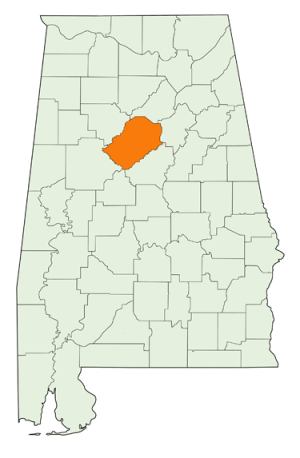Jefferson County: Difference between revisions
No edit summary |
|||
| Line 1: | Line 1: | ||
[[Image:Jefferson County Seal.png|right|200px]] | [[Image:Jefferson County Seal.png|right|200px]] | ||
'''Jefferson County''' (established [[December 13]], [[1819]]) is Alabama's most populous county and the center of the [[Birmingham-Hoover-Cullman Metropolitan Area]]. The county seat is split into two judicial districts: [[Birmingham]], home of the main courthouse and the chambers of the [[Jefferson County Commission]], and [[Bessemer]], where a second courthouse handles cases from the western part of the county. | '''Jefferson County''' (established [[December 13]], [[1819]]) is Alabama's most populous county and the center of the [[Birmingham-Hoover-Cullman Metropolitan Area]]. The county seat is split into two judicial districts: [[Birmingham]], home of the [[Jefferson County Courthouse|main courthouse]] and the chambers of the [[Jefferson County Commission]], and [[Bessemer]], where a second courthouse handles cases from the western part of the county. | ||
==Geography== | ==Geography== | ||
Revision as of 14:24, 31 January 2011
Jefferson County (established December 13, 1819) is Alabama's most populous county and the center of the Birmingham-Hoover-Cullman Metropolitan Area. The county seat is split into two judicial districts: Birmingham, home of the main courthouse and the chambers of the Jefferson County Commission, and Bessemer, where a second courthouse handles cases from the western part of the county.
Geography
According to the U.S. Census Bureau, the county has a total area of 1,124 square miles. 1,113 mi² of it is land and 11 mi² (1%) of it is water.
The county is located in the north-central portion of the state, on the southern extension of the Appalachians, in the center of the iron, coal and limestone belt of the South. Jefferson County is bordered by Blount, Bibb, St. Clair, Shelby, Tuscaloosa, and Walker counties. It encompasses 1,119 square miles. The county seat was at Carrollsville from 1819-21, at Elyton from 1821-73, and since 1873 has been at Birmingham.
See also: List of Jefferson County municipalities and List of Jefferson County communities.
History
In 1814, before Alabama became a state, the area now designated as Jefferson County was part of Monroe County in the Mississippi Territory. In 1816 a section of Monroe County was divided out and named Montgomery County. In 1818 a section of Montgomery County was carved out and named Blount County, with its seat at the home of Judge Moses Kelley in eastern Jones Valley.
A bitter scuffle between factions of northern and southern Blount County resulted in another split later that same year. Jefferson County was established on December 13, 1819 by the Alabama legislature, then meeting in Huntsville. It was named in honor of Thomas Jefferson. third president of the United States.
Government
Jefferson County is one of the few counties in Alabama that has a limited-form of home rule government. This limited ability of home rule allows the county to be able to establish its own land use zoning, maintain sewers and roads, carry out garbage disposal, and enforce taxation (except property taxes).
Jefferson County's administrative and legislative body is the five-member Jefferson County Commission. As of September 2009 the president of the Commission is Bettye Fine Collins.
The dual court districts came about when the state legislature made preparations to split off a portion of Jefferson county to create a new county with Bessemer as its county seat. The idea was dropped but the additional courthouse and parallel positions remain. The main courthouse is in Birmingham and the second, known as the Jefferson County Courthouse Bessemer Division, is located in Bessemer. In order to better serve citizens in western Jefferson County, most assistant officials, such as the Assistant District Attorney, Assistant Tax Assessor, and Assistant Tax Collector have their offices in the Bessemer Annex.
Law enforcement
Jefferson County is served by the Jefferson County Sheriff's Department. The Sheriff is chosen in an at-large election. The current Sheriff is Mike Hale, who was re-elected in 2006. The department fields about 175 officers who patrol the unincorporated areas of the county and municipalities that do not have their own police. They also participate in special operations within other police districts. The Department maintains two jails, one in Birmingham and one in Bessemer, housing inmates awaiting trial and serving sentences.
Schools
Except for cities that have established their own local school districts, all parts of Jefferson County outside of the city limits of Birmingham are served by Jefferson County School System.
Taxation
From 1967 until January 1, 2005, Jefferson County collected a 1% sales tax on general purchases in the county. In October 2004 a Commission voted to add an additional 1% sales tax to fund bonds for school construction.
Debt crisis
The Jefferson County sewer system incurred enormous debts in the late 1990s for repairs, upgrades and expansion of its sewer and water treatment infrastructure. Part of the work was required by a 1996 consent decree forged to insure that the system complied with the requirements of the federal Clean Water Act. Other expansion was undertaken at the same time to add ratepayers to the system to help pay back the debt and to promote development in the county. As costs continued to climb, rate-payers saw their sewer rates shoot upwards to service the bond debt. A 2003 audit of the sewer project found a critical lack of planning, unqualified project management, serious accounting deficiencies, and arrangements with contractors that opened the county to unusual risk. Later it was found that numerous county officials had accepted bribes from contractors.
Efforts to hold down increases in sewer rates led the county to negotiate numerous refinancings of its bond debts. Following the advice of outside financial consultants and its own finance director, Jefferson County entered into an extraordinary number of interest rate swaps. Inquiries into those deals found that the county was paying its advisors and bankers unusually high fees and the Securities and Exchange Commission has opened an investigation of possible violations of securities laws.
Due to a national crisis in the mortgage lending sector which emerged in 2007, the insurers, which were supposed to have kept the bonds' variable interests rates low, were no longer able to cover the bonds. As a result, interest rates shot up from around 3% to over 10% at variable-rate auction. With no ability to cover the massive debt service payments, the county entered into emergency negotiations with its bondholders and began openly considering Chapter 9 bankruptcy. If the county did default on its debts, it would be the largest bankruptcy by a municipal government in United States history.
In June 2009, after the Alabama Legislature failed to replace the illegal Jefferson County Occupational Tax and no solution had been reached in the sewer debt crisis, the County Commission voted to close its satellite courthouses, cut hourly workers to four-day weeks, suspend all road maintenance contracts in cities, postpone opening the Jefferson County Bessemer Justice Center, and suspend non-essential travel. The cuts are expected to save $38 million. Additional cuts are expected as the county labors to make up for a $78 million budget deficit.
Demographics
As of the census of 2000, there were 662,047 people, 263,265 households, and 175,861 families residing in the county. The population density was 595/mi². There were 288,162 housing units at an average density of 259/mi². The racial makeup of the county was 58% White and 39% Black or African American. 1.5% of the population were Hispanic or Latino of any race.
There were 263,265 households out of which 30.80% had children under the age of 18 living with them, 46.10% were married couples living together, 17.20% had a female householder with no husband present, and 33.20% were non-families. 28.70% of all households were made up of individuals and 9.90% had someone living alone who was 65 years of age or older. The average household size was 2.45 and the average family size was 3.04.
In the county the population was spread out with 24.80% under the age of 18, 9.60% from 18 to 24, 29.70% from 25 to 44, 22.30% from 45 to 64, and 13.60% who were 65 years of age or older. The median age was 36 years. For every 100 females there were 89.20 males. For every 100 females age 18 and over, there were 84.50 males.
The median income for a household in the county was $36,868, and the median income for a family was $45,951. Males had a median income of $35,954 versus $26,631 for females. The per capita income for the county was $20,892. 14.80% of the population and 11.60% of families were below the poverty line. 20.20% of those under the age of 18 and 12.70% of those 65 and older were living below the poverty line.
Census estimates show a marginal gain of 2,980 residents by 2009 for an estimated current population of 665,027
References
- Wright, Barnett (June 16, 2009) "Jeffco slashes budget $38 million in host of cuts, closures." Birmingham News
External links
- Official Website of Jefferson County
- Jefferson County Department of Health
- Jefferson County Library System
- Jefferson County Sheriff's Department
| Jefferson County | |
|---|---|
| Topics |
Communities | County Commission | Courts | Schools | Sheriff |
| Cities |
Adamsville | Bessemer (seat) | Birmingham (seat) | Brighton | Brookside | Cardiff | Center Point | Clay | Fairfield | Fultondale | Gardendale | Graysville | Homewood | Hoover | Hueytown | Irondale | Kimberly | Leeds | Lipscomb | Maytown | Midfield | Morris | Mountain Brook | Mulga | North Johns | Pinson | Pleasant Grove | Sylvan Springs | Tarrant | Trafford | Trussville | Vestavia Hills | Warrior | West Jefferson |

